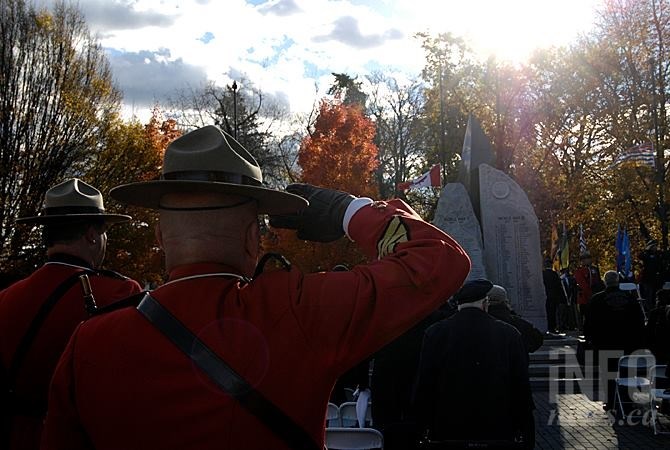
Remembrance Day 2005
(ADAM PROSKIW / iNFOnews.ca)
November 11, 2022 - 7:00 AM
— This story was originally published in November, 2020
More than 100 soldiers from Kamloops and the Okanagan were sent overseas to Afghanistan, a feat that an Okanagan College history professor who served in the B.C. Dragoon wants to ensure isn’t forgotten.
Howard Hisdal was with the British Columbia Dragoons from 1996 to 2014, and during the Afghanistan War he trained and recruited soldiers to send overseas and helped maintained the regiment.
“That’s where my interest is, these are people that I really felt responsible for,” he said.
READ MORE: Remembrance Day is going to look at lot different in Kamloops, Okanagan this year
The war in Afghanistan lasted from 2001 to 2014 and was Canada’s longest war and its first significant combat engagement since the Korean War, according to The Canadian Encyclopedia. It began shortly after the terrorist attacks in New York in 2001. Canada joined an international coalition to destroy the al-Qaeda terrorist network and the Taliban regime that sheltered in the country.
The British Columbia Dragoons sent some 33 soldiers from Penticton, Kelowna and Vernon to Afghanistan, Hisdal said. They were employed in roles such as convoy escort, supporting the Canadian main battle tank squadron, operating the observation balloon, training the Afghan National Army and conducting civil-military affairs.
A female soldier, a sergeant trained as a clerk, came home in a wheelchair after she was badly wounded by Taliban rocket fire, he said. She was serving in the civil-military role supervising Canadian foreign aid projects, talking to village elders and was in command of a two-vehicle patrol. She now walks without a limp.
One Penticton soldier, Capt. Jonathan Snyder, won the Star of Military Valour, the highest medal awarded by the Canadian government during the Afghanistan mission, but died before he could receive it.
Snyder was mentoring roughly 55 Afghan National Army recruit soldiers at the time, and they were on a training march when Taliban fire pinned them behind a mud brick wall.
Capt. Snyder told the soldiers to fight back and then showed them how by popping up at different spots along the wall and firing, they were able to win the firefight, Hisdal said, but he never got his star because he died three days later on a night patrol when he stepped into a deep well.
Kamloops and the Rocky Mountain Rangers sent soldiers as well. The numbers probably equalled close to 100 people, including civilian contractors and personnel in the regular force, he said.
“It was a long period of conflict for the military and it went through different phases too,” Hisdal said. “Changing a society can’t be done overnight. Our mission to train the Afghan National Army and training the Afghan National Police force seems to have actually worked. It’s not a perfect model Western State (but it seems to be) limping along."
From the Afghan war he said “we can learn that getting involved in these types of missions are long term. We still have troops training forces in Northern Iraq.”
“It was long, there were no spectacular moments for Canada particularly and it does tend to be forgotten and it didn't have a clear cut ending... eventually Afghanistan will be a modern country. It will take time, they will do it at their own pace... in a way Canada did seriously help them,” he said.
He said it needs to be commemorated just like the Second World War.
Hisdal believes the longer, multi-generational war is the present and future of war and while more tedious, avoids more bloodshed in the long run.
International terrorism will always be around in some form, he said.
“Terrorism is a low level and an inexpensive form of war. It’s often called fourth-generation war where you don’t even send your troops into the other country, you just send internet messages and recruit people over the internet and they make the weapons and buy the weapons and use them… it’s difficult to stop. Education is one way, but there’s always going to be people who are unhappy.”
Before his retirement from the Dragoons, Hisdal helped design and unveil a plaque dedicated to Canada’s mission in Afghanistan at the Kelowna International Airport in 2014. The airport is where the B.C. Dragoons returned home.
Hisdal will be speaking on the topic Saturday, Oct. 31 from 2 until 3 p.m. at the Okanagan Military Museum in Kelowna. The event is free and registration is open online via Zoom and in person. Tickets are available through Eventbrite here.
To contact a reporter for this story, email Carli Berry or call 250-864-7494 or email the editor. You can also submit photos, videos or news tips to the newsroom and be entered to win a monthly prize draw.
We welcome your comments and opinions on our stories but play nice. We won't censor or delete comments unless they contain off-topic statements or links, unnecessary vulgarity, false facts, spam or obviously fake profiles. If you have any concerns about what you see in comments, email the editor in the link above.
News from © iNFOnews, 2022